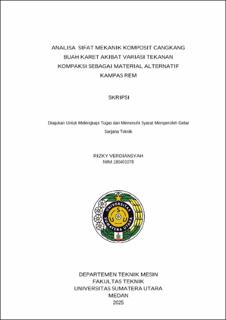| dc.contributor.advisor | Nasution, Fadly Ahmad Kurniawan | |
| dc.contributor.author | Verdiansyah, Rizky | |
| dc.date.accessioned | 2025-02-20T03:01:48Z | |
| dc.date.available | 2025-02-20T03:01:48Z | |
| dc.date.issued | 2025 | |
| dc.identifier.uri | https://repositori.usu.ac.id/handle/123456789/101481 | |
| dc.description.abstract | Motorized vehicles are used to dissipate the vehicle's motion energy so that the vehicle slows down. The working principle of this brake is that there is friction between the disc and the brake pad when these two brake components come into contact. So that with this friction, the kinetic energy coming from the vehicle is converted into heat. Based on this, a solution is needed to handle it by utilizing the potential of rubber fruit shells, as well as increasing the economic value of the waste. Thus, research is needed to make brake pads using composite materials made from rubber fruit shell waste as an alternative material for motorcycle brake pads. Rubber fruit shell composites are made with several loading variations, with variation I: 2 ton loading, variation II: 3 ton loading and variation III: 4 ton loading. In this study, several tests were carried out, namely friction testing, microstructure and hardness testing to get results that are close to conventional motorcycle brake pads on the market. In this conclusion, it can be obtained that the effect of the variation in compaction pressure on the hardness value, wear rate and microstructure of the specimen of the brake pad material of the rubber fruit shell material is greater the pressure of the compaction load, the results obtained are also closer to those on the market. Variation in compression loading in the analysis of mechanical properties of rubber fruit shell composites due to compression pressure variations as an alternative material for motorcycle brake pads that get the maximum value with a hardness value of 28.43 BHN and a wear rate value of with the influence of variations in compaction loading on specimens. This test obtained the highest hardness result at the loading of a 4-ton compaction with a hardness value of 28.43 BHN and the lowest hardness value at a 2-ton loading with a hardness value of 19.90 BHN. Analysis of the mechanical properties of rubber fruit shell composites due to compression pressure variations as an alternative material for motorcycle brake pads obtained the lowest wear rate value with the value of at the loading variation of 2 tons and the result of the highest wear rate valueon the variation of compac tion loading at a load of 4 tons. This test obtained the results that the microstructure in the specimen had a difference in the variation of the loading of the compact, in the loading complex of 2 tons and 3 tons had a non-homogeneous microstructure so that the distribution of powder on the specimen was uneven. In loading, the 4-ton Compaction has a homogeneous microstructure so that the powder is evenly distributed. | en_US |
| dc.language.iso | id | en_US |
| dc.publisher | Universitas Sumatera Utara | en_US |
| dc.subject | Powder Composite | en_US |
| dc.subject | Wear Test | en_US |
| dc.subject | Strength Test | en_US |
| dc.subject | Microstructure Test | en_US |
| dc.title | Analisa Sifat Mekanik Komposit Cangkang Buah Karet Akibat Variasi Tekanan Kompaksi Sebagai Material Alternatif Kampas Rem | en_US |
| dc.title.alternative | Analysis Of Mechanical Properties Of Rubber Fruit Shell Composites Due To Compression Pressure Variations As An Alternative Material For Brake Pads | en_US |
| dc.type | Thesis | en_US |
| dc.identifier.nim | NIM180401078 | |
| dc.identifier.nidn | NIDN0112088603 | |
| dc.identifier.kodeprodi | KODEPRODI21201#Teknik Mesin | |
| dc.description.pages | 86 Pages | en_US |
| dc.description.type | Skripsi Sarjana | en_US |
| dc.subject.sdgs | SDGs 4. Quality Education | en_US |


